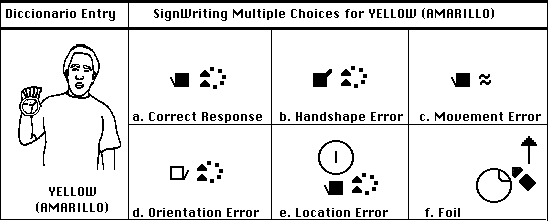 Literacy In Nicaraguan Sign
Language
Literacy In Nicaraguan Sign
Language
Assessing
"Written Sign" Recognition Skills
at the Escuelita de Bluefields
by
Janice Gangel-Vasquez
PVasqEZ@aol.com
California State University
Dominguez Hills, California
|


|
Summary
This study is a master's degree thesis by Janice Gangel-Vasquez,
completed Winter 1997 at California State University at Dominguez
Hills, California. It is important for the history of SignWriting
since it is the first study testing "sign language literacy"
using SignWriting. Literacy levels of deaf children in Nicaragua
were studied and the results point to success in reading signs.
Quoting from the thesis:
"The test results indicate that even beginning signers can
be taught to recognize written signs. Further, there is evidence
that achievement of "sign language literacy" may open
the door to literacy in an oral language."
Abstract April-May, 1998
LITERACY IN NICARAGUAN SIGN LANGUAGE
Assessing "Written Sign" Recognition Skills
at the Escuelita de Bluefields
By Janice M. Gangel-Vasquez

Presented at the following conferences:
1. Impact of Deafness on Cognition, AERA Conference. San Diego,
California. April 13-14, 1998.
2. SALSA, Sixth Annual Symposium about Language and Society.
University of Texas, Austin, April 24-26, 1998
3. California State University 12th Annual Student Research Competition,
California State University, Chico, May 1-2, 1998

|
HYPOTHESIS
Deaf students of the sign language school of Bluefields, Nicaragua,
are acquiring their first language, Nicaraguan
sign language, at a very late age. It is hypothesized
that even those with very late first-language-acquisition can
achieve literacy, if "literacy" is defined as reading
their native language as transcribed in the "alphabet"
of SignWriting (SW),
a system for recording body movement and facial expressions.
BACKGROUND
Before 1995, the deaf of the Atlantic Coast of Nicaragua had
no language. They communicated in home signs, which are highly
idiosyncratic and variable signs differing from one family to
the next. Since the establishment of the Escuelita
de Bluefields in Bluefields, students have been acquiring
their primary (sign) language simultaneously with learning literacy
(learning to read signs). The students, who range in age from
6 to 36, are not required to learn a second, oral language in
order to access written literature; rather they are taught to
read Nicaraguan sign language.
STUDY PARTICIPANTS
The 15 deaf participants are grouped by age of introduction to
sign language: fluent signers, pre-puberty and post-puberty groups
of students who have been acquiring Nicaraguan sign language
since 1995, and students who range in age from 13 to 22 years
and with less than 6 months of sign language acquisition.
METHODS AND MATERIALS
Responses to 45 multiple-choice problems measure recognition
of several salient features of Nicaraguan sign language. Each
test item consists of 6 randomly-arranged options (correct sign;
errors of handshape, orientation, movement, location; and a nonsense
sign) written in SignWriting and presented opposite a picture
of the target sign, which is signed by the presenter. See below...

|
Above. Typical signed dictionary entry for YELLOW (AMARILLO)
and the SignWriting test item for YELLOW. Each test item consists
of random order presentation of the six options opposite a picture
of the target sign, which is simultaneously signed by the test
director.
RESULTS
Four members of the study group scored at least 75% correct:
2 fluent signers, a post-puberty student with 3 years sign language
acquisition, and a puberty-aged student with only a few months
of sign language acquisition.
The test results indicate that even beginning signers can
be taught to recognize written signs. Further, there is evidence
that achievement of "sign language literacy" may open
the door to literacy in an oral language.
The results also suggest that fluency in sign language does
not bestow literacy in SignWriting, since a fluent-signing 23-year-old
participant, with very little SignWriting training, scored less
than 50% on the test.
IMPLICATIONS AND VALUE OF THE STUDY
This study establishes a base line of literacy for the 15 participants.
The test can be used in future evaluation of their reading skills
and can become part of the existing battery of tests, which includes
the videotaping of students' signing as they progress through
the school.
Learning some level of literacy through SignWriting is possible
for this very late first-language-acquisition population.
To counterpose teaching literacy in the dominant oral language
of the country...in the Bluefields case, English or Spanish...does
not appear to be a reasonable approach. However, for a few of
the students, SignWriting may be a bridge to learning to read
an oral-based language, as indicated by Antonio, who is currently
accessing many written Spanish words through his knowledge of
SignWriting.

|
|
Would you like a photocopy of this entire thesis? The paper
version includes more diagrams and a Table that lists the results
of the tests. To receive a copy through snail mail, write to
the author:
Janice Gangel-Vasquez
PVasqEZ@aol.com


|